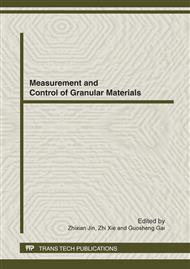p.16
p.21
p.25
p.29
p.33
p.38
p.43
p.47
p.51
Particle Size Analysis by Laser Diffraction Method Using Reference Particles
Abstract:
The particle size analysis (PSA) by laser diffraction (LD) method can be used for monitor or control of particulate process, because it has the advantages of shorter measurement time and good repeatability, and a variety of commercial instruments is available. However particle size distribution (PSD) measured by LD method depends a great deal on not only optical detector configuration and calculation procedure but also on the system of sample loading into the measuring zone. From this fact, the validation of PSA by LD method should be done using reference particles (RP), whose size distribution is better to have a range over one decade of size, according to ISO 13320-1. For this purpose, the Association of Powder Process Industry and Engineering, Japan (APPIE) distribute the spherical barium titanate glass particles as RP of JIS Z 8900-1, whose size ranges are 1 - 10 µm (MBP 1 - 10), 3 - 30 µm (MBP 3 - 30) and 10 - 100 µm (MBP 10 - 100). This paper shows why LD method needs to check its performance by using RP, and then reports the results of the round robin test of two kinds of RP (MBP 1 - 10 and MBP 10 - 100) and silica RP candidate with 0.1 1.0 µm size measured by LD instruments, which was conducted by the Technical Group of Measurement and Control in APPIE. PSD results measured by LD instruments were almost same as each other for both RP samples. MBP 1 - 10 sample was well dispersed in water without detergent, but a few drops of detergent sometimes needed for dispersing MBP 10 - 100 sample. For MBP 1 - 10 sample, PSD by LD method was slightly smaller than that measured by scanning electro microscopy (SEM) or electro sensing zone (ESZ) methods. For MBP 10 - 100 sample, PSD by LD method agreed well with that by SEM or ESZ methods. Silica sample can be supplied to the users as the dry powder, which can be re-dispersed in water with small amount of surfactant. From the results of the round robin test using silica sample, PSD measured by LD method roughly agreed with EM method.
Info:
Periodical:
Pages:
33-37
Citation:
Online since:
April 2012
Authors:
Price:
Сopyright:
© 2012 Trans Tech Publications Ltd. All Rights Reserved
Share:
Citation:


